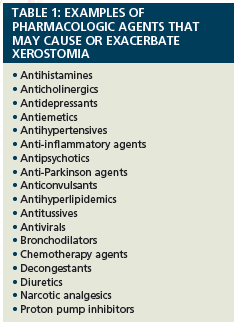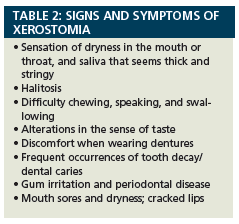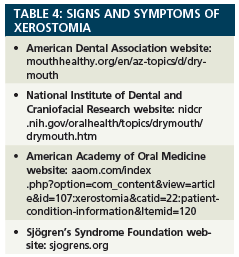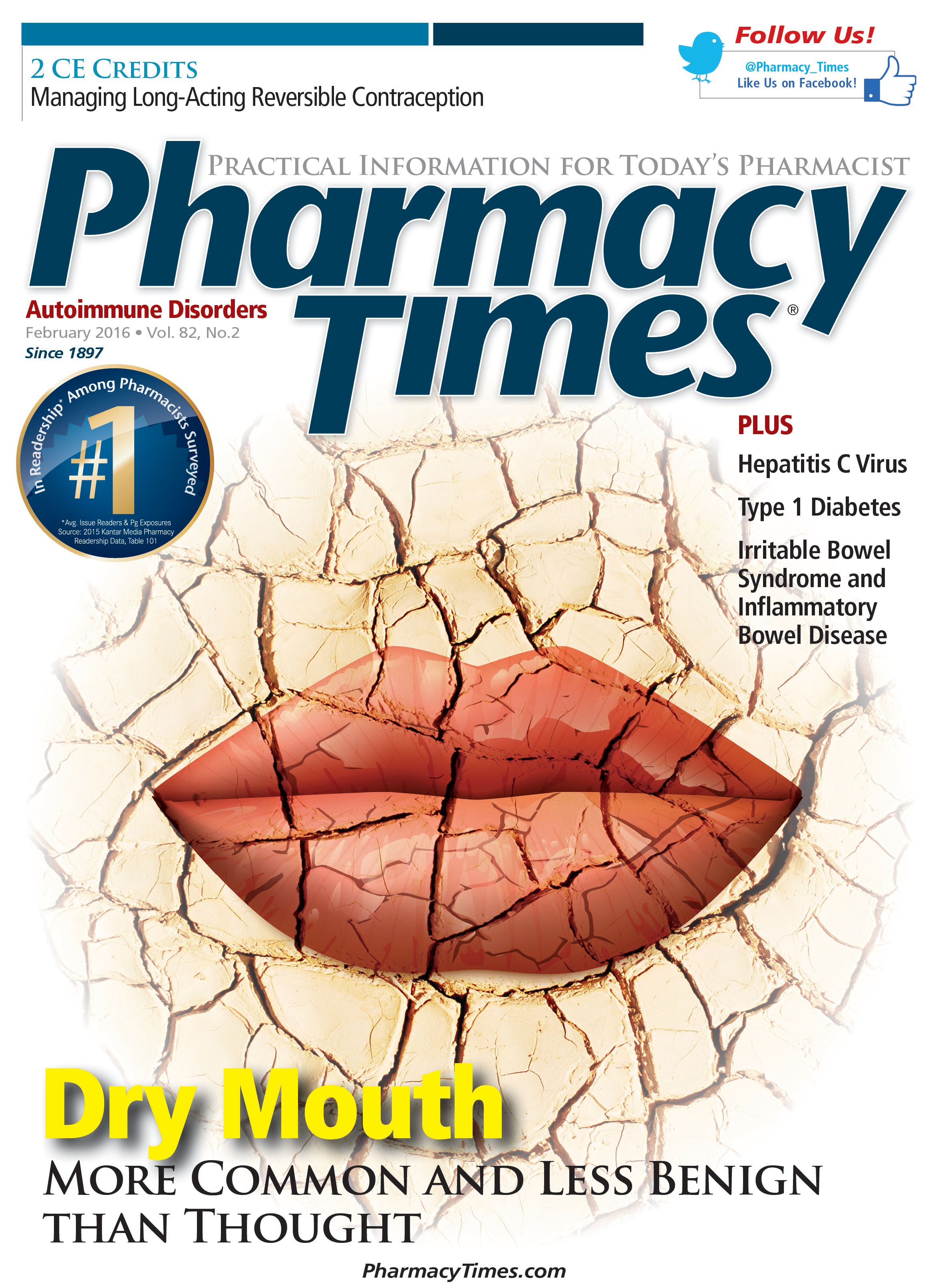Publication
Article
Pharmacy Times
Dry Mouth: More Common and Less Benign than Thought
Author(s):
Everyone may occasionally experience the unpleasant sensation of dry mouth (xerostomia), but some individuals endure the discomfort of dry mouth on a regular basis.
Everyone may occasionally experience the unpleasant sensation of dry mouth (xerostomia), but some individuals endure the discomfort of dry mouth on a regular basis.

Saliva has many essential health functions, including lubrication of the oral cavity, remineralization, protection against tooth decay, antimicrobial and buffering properties, assistance with swallowing and digestion, control of pH, and overall maintenance of the oral mucosa.1,2,4 If left untreated, xerostomia can cause discomfort and contribute to halitosis, dental caries, periodontal disease, and other oral health problems, such as candidiasis infection due to disturbance of the oral microflora resulting from decreased salivary flow.1,2

Causes
Xerostomia can be caused by a variety of factors, including adverse effects of certain medications and medical conditions (eg, Sjögren’s syndrome, poorly controlled diabetes, HIV/AIDS, uncontrolled hypertension, hepatitis C virus infection, lymphoma, hormonal changes due to menopause, radiation therapy, chemotherapy, nerve damage).1-5 Sjögren’s syndrome is considered to be a major cause of xerostomia in many individuals.1-5 Nonpharmacologic causes of xerostomia include the use of alcohol or tobacco, or the consumption of excessive caffeine or spicy foods.1 Examples of classes of pharmacologic agents frequently associated with causing or exacerbating xerostomia can be found in Table 1.1-5
Clinical Presentation
The severity of xerostomia varies among individuals. Common signs and symptoms are listed in Table 2.1-5
OTC Products for Managing Xerostomia
The goals of treating xerostomia include identifying the possible cause, relieving discomfort, and preventing complications such as dental caries and periodontal infections.1 A host of artificial saliva products are available to treat and prevent xerostomia, and they come in formulations such as rinses, sprays, toothpastes, gels, lozenges, and gum (Table 3). Artificial saliva products are formulated to mimic the chemical and physical properties of natural saliva; however, they do not contain the protective measures of natural saliva.1,2 Artificial saliva products typically contain carboxymethylcellulose and glycerin for viscosity, as well as calcium and phosphate ions.1,2 Some products contain fluoride and/or a flavoring agent/sweetener (ie, xylitol, sorbitol).1,2 Patients should be reminded that these products are classified as replacement products and not cures for xerostomia.1
Table 3: Examples of OTC Products for Xerostomia
· ACT Total Care Dry Mouth Lozenges
· Biotene Dry Mouth Toothpaste
· Biotene Oral Balance Dry Mouth Moisturizing Gel
· Biotene Mouth Spray for Dry Mouth
· Biotene PBF Oral Rinse
· Biotene Oral Rinse
· MedActive Oral Relief Gel for Dry Mouth
· MediActive Oral Relief Lozenges for Dry Mouth
· Orajel Dry Mouth Moisturizing Gel
· Oasis Moisturizing Mouthwash for Dry Mouth
· Oasis Moisturizing Mouth Spray for Dry Mouth
· Salese Dry Mouth Relief Moisturizing Lozenges
· Salivart Oral Moisturizer Spray
· SalivaSure Lozenges
· SmartMouth Dry Mouth Relief Mints
· Stoppers 4 Dry Mouth Spray
· TheraBreath Mouth Wetting Lozenges
· XyliMelts Discs for Dry Mouth

Conclusion
Pharmacists can be instrumental in identifying individuals at risk for developing xerostomia due to the use of certain classes of pharmacologic agents, medical conditions, and factors such as tobacco and alcohol use. Prior to recommending OTC products for preventing or managing xerostomia, pharmacists should ascertain whether self-treatment is appropriate and encourage patients to discuss xerostomia with their primary health care provider, especially if symptoms persist or worsen. During counseling, it is imperative that pharmacists remind patients about the importance of daily oral hygiene, including brushing and flossing at least twice a day to decrease or prevent dental caries and periodontal disease. Moreover, pharmacists can suggest various nonpharmacologic measures that may alleviate mild xerostomia; these measures include chewing gum with xylitol, using sugar-free hard candy to increase the flow of saliva, and avoiding caffeinated beverages, alcohol, and smoking. If symptoms persist or worsen despite self-treatment, patients should be advised to see their dentist for other treatment options. Additional resources are listed in Table 4.
Ms. Terrie is a clinical pharmacy writer based in Haymarket, Virginia.
References
- Albanese N. Oral pain and discomfort. In: Krinsky D, Berardi R, Ferreri S, et al, eds. Handbook of Nonprescription Drugs. 18th ed. Washington, DC: American Pharmacists Association; 2015.
- Bartels CL. Xerostomia. The Oral Cancer Foundation website. oralcancerfoundation.org/complications/xerostomia.php. Accessed November 25, 2015.
- Xerostomia (dry mouth). American Dental Association website. ada.org/en/member-center/oral-health-topics/xerostomia. Accessed November 25, 2015.
- Sankar V, Rhodus N; AAOM Web Writing Group. Xerostomia. The American Academy of Oral Medicine website. aaom.com/index.php?option=com_content&view=article&id=107:xerostomia&catid=22:patient-condition-information&Itemid=120. Updated October 15, 2015. Accessed November 25, 2015.
- Xerostomia. Cancer.net website. cancer.net/navigating-cancer-care/side-effects/dry-mouth-or-xerostomia. Accessed November 25, 2015.







